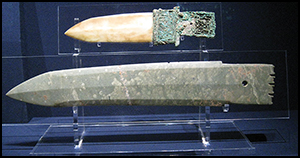Crossref Citations
This article has been cited by the following publications. This list is generated based on data provided by
Crossref.
2017.
ANNUAL BIBLIOGRAPHY.
Early China,
Vol. 40,
Issue. ,
p.
333.
Liu, S.
Chen, K. L.
Rehren, Th.
Mei, J. J.
Chen, J. L.
Liu, Y.
and
Killick, D.
2018.
Did China Import Metals from Africa in the Bronze Age?.
Archaeometry,
Vol. 60,
Issue. 1,
p.
105.
Hsu, Y.‐K.
Rawson, J.
Pollard, A. M.
Ma, Q.
Luo, F.
Yao, P.‐H.
and
Shen, C.‐C.
2018.
Application of Kernel Density Estimates to Lead Isotope Compositions of Bronzes from Ningxia, North‐West China.
Archaeometry,
Vol. 60,
Issue. 1,
p.
128.
Lü, Hongliang
2018.
Encyclopedia of Global Archaeology.
p.
1.
Liu, Ruiliang
Pollard, A. Mark
Rawson, Jessica
Tang, Xiaojia
Bray, Peter
and
Zhang, Changping
2019.
Panlongcheng, Zhengzhou and the Movement of Metal in Early Bronze Age China.
Journal of World Prehistory,
Vol. 32,
Issue. 4,
p.
393.
Rawson, Jessica
2019.
Ordering the material world of the Western Zhou.
Archaeological Research in Asia,
Vol. 19,
Issue. ,
p.
100096.
Pollard, A. M.
Liu, R.
Rawson, J.
and
Tang, X.
2019.
From Alloy Composition to Alloying Practice: Chinese Bronzes.
Archaeometry,
Vol. 61,
Issue. 1,
p.
70.
Zhang, Chi
Pollard, A. Mark
Rawson, Jessica
Huan, Limin
Liu, Ruiliang
and
Tang, Xiaojia
2019.
China's major Late Neolithic centres and the rise of Erlitou.
Antiquity,
Vol. 93,
Issue. 369,
p.
588.
Cui, Jianxin
Sun, Zhouyong
Burr, George S.
Shao, Jing
and
Chang, Hong
2019.
The great cultural divergence and environmental background of Northern Shaanxi and its adjacent regions during the late Neolithic.
Archaeological Research in Asia,
Vol. 20,
Issue. ,
p.
100164.
Chen, G.
Cui, Y.
Liu, R.
Wang, H.
Yang, Y.
Pollard, A. M.
and
Li, Y.
2020.
Lead isotopic analyses of copper ores in the Early Bronze Age central Hexi Corridor, north‐west China.
Archaeometry,
Vol. 62,
Issue. 5,
p.
952.
Guo, Yi
Lou, Jia
Xie, Shiyu
Wu, Xinhua
and
Fuller, Benjamin T.
2020.
Isotopic reconstruction of human diet in the Ji'erzankale site, Xinjiang Uyghur Autonomous Region, China.
International Journal of Osteoarchaeology,
Vol. 30,
Issue. 1,
p.
65.
Rawson, Jessica
Chugunov, Konstantin
Grebnev, Yegor
and
Huan, Limin
2020.
Chariotry and Prone Burials: Reassessing Late Shang China’s Relationship with Its Northern Neighbours.
Journal of World Prehistory,
Vol. 33,
Issue. 2,
p.
135.
Huang, Xiaozhong
Zhang, Jun
Storozum, Michael
Liu, Sisi
Gill, Jacquelyn L.
Xiang, Lixiong
Ren, Xiuxiu
Wang, Jiale
Qiang, Mingrui
Chen, Fahu
and
Grimm, Eric C.
2020.
Long-term herbivore population dynamics in the northeastern Qinghai-Tibetan Plateau and its implications for early human impacts.
Review of Palaeobotany and Palynology,
Vol. 275,
Issue. ,
p.
104171.
Lü, Hongliang
2020.
Encyclopedia of Global Archaeology.
p.
10669.
Huang, Xiaozhong
Xiang, Lixiong
Lei, Guoliang
Sun, Mingjie
Qiu, Menghan
Storozum, Michael
Huang, Chong
Munkhbayar, Chuluunbat
Demberel, Otgonbayar
Zhang, Jun
Zhang, Jiawu
Chen, Xuemei
Chen, Jianhui
and
Chen, Fahu
2021.
Sedimentary Pediastrum record of middle–late Holocene temperature change and its impacts on early human culture in the desert-oasis area of northwestern China.
Quaternary Science Reviews,
Vol. 265,
Issue. ,
p.
107054.
Zhang, Jun
Huang, Xiaozhong
Zhang, Shengrui
Ren, Xiuxiu
Xiao, Yulin
Wang, Jiale
Xiang, Lixiong
Xu, Qinghai
and
Birks, Harry John Betteley
2021.
Cycles of grazing and agricultural activity during the historical period and its relationship with climatic and societal changes in northern China.
Land Degradation & Development,
Vol. 32,
Issue. 11,
p.
3315.
He, Yahui
Liu, Li
Sun, Zhouyong
Shao, Jing
and
Di, Nan
2021.
“Proposing a toast” from the first urban center in the north Loess Plateau, China: Alcoholic beverages at Shimao.
Journal of Anthropological Archaeology,
Vol. 64,
Issue. ,
p.
101352.
Liu, Ruiliang
Dong, Guanghui
Ma, Minmin
and
Pollard, A Mark
2021.
Introduction to the Special Issue: Correlating changes for environmental, technological and societal transformation in prehistoric eastern Asia.
The Holocene,
Vol. 31,
Issue. 2,
p.
165.
Dong, Guanghui
Du, Linyao
and
Wei, Wenyu
2021.
The impact of early trans-Eurasian exchange on animal utilization in northern China during 5000–2500 BP.
The Holocene,
Vol. 31,
Issue. 2,
p.
294.
Liu, Ruiliang
Pollard, A. Mark
Lv, Feiya
Huan, Limin
Zhang, Shanjia
and
Ma, Minmin
2021.
Two Sides of the Same Coin: A Combination of Archaeometallurgy and Environmental Archaeology to Re-Examine the Hypothesis of Yunnan as the Source of Highly Radiogenic Lead in Early Dynastic China.
Frontiers in Earth Science,
Vol. 9,
Issue. ,



